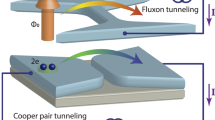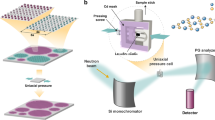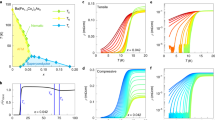Abstract
Measurements on nanoscale structures constructed from high-temperature superconductors are expected to shed light on the origin of superconductivity in these materials1,2,3,4,5,6,7. To date, loops made from these compounds have had sizes of the order of hundreds of nanometres8–11. Here, we report the results of measurements on loops of La1.84Sr0.16CuO4, a high-temperature superconductor that loses its resistance to electric currents when cooled below ∼38 K, with dimensions down to tens of nanometres. We observe oscillations in the resistance of the loops as a function of the magnetic flux through the loops. The oscillations have a period of h/2e, and their amplitude is much larger than the amplitude of the resistance oscillations expected from the Little–Parks effect12,13. Moreover, unlike Little–Parks oscillations, which are caused by periodic changes in the superconducting transition temperature, the oscillations we observe are caused by periodic changes in the interaction between thermally excited moving vortices and the oscillating persistent current induced in the loops. However, despite the enhanced amplitude of these oscillations, we have not detected oscillations with a period of h/e, as recently predicted for nanoscale loops of superconductors with d-wave symmetry1,2,3,4,5,6, or with a period of h/4e, as predicted for superconductors that exhibit stripes7.
This is a preview of subscription content, access via your institution
Access options
Subscribe to this journal
Receive 12 print issues and online access
$259.00 per year
only $21.58 per issue
Buy this article
- Purchase on Springer Link
- Instant access to full article PDF
Prices may be subject to local taxes which are calculated during checkout




Similar content being viewed by others
References
Barash, Y. S. Low-energy subgap states and the magnetic flux periodicity in d-wave superconducting rings. Phys. Rev. Lett. 100, 177003 (2008).
Juricic, V., Herbut, I. F. & Tesanovic, Z. Restoration of the magnetic hc/e-periodicity in unconventional superconductors. Phys. Rev. Lett. 100, 187006 (2008).
Loder, F. et al. Magnetic flux periodicity of h/e in superconducting loops. Nature Phys. 4, 112–115 (2008).
Vakaryuk, V. Universal mechanism for breaking the hc/2e periodicity of flux-induced oscillations in small superconducting rings. Phys. Rev. Lett. 101, 167002 (2008).
Wei, T.-C. & Goldbart, P. M. Emergence of h/e-period oscillations in the critical temperature of small superconducting rings threaded by magnetic flux. Phys. Rev. B 77, 224512 (2008).
Zhu, J.-X. & Quan, H. T. Magnetic flux periodicity in a hollow d-wave superconducting cylinder. Phys. Rev. B 81, 054521 (2010).
Berg, E., Fradkin, E. & Kivelson, S. A. Charge-4e superconductivity from pair-density-wave order in certain high-temperature superconductors. Nature Phys. 5, 830–833 (2009).
Gammel, P. L., Polakos, P. A., Rice, C. E., Harriott, L. R. & Bishop, D. J. Little–Parks oscillations of Tc in patterned microstructures of the oxide superconductor YBa2Cu3O7: experimental limits on fractional-statistics-particle theories. Phys. Rev. B 41, 2593–2596 (1990).
Castellanos, A., Wordenweber, R., Ockenfuss, G., Hart, A. v. d. & Keck, K. Preparation of regular arrays of antidots in YBa2Cu3O7 thin films and observation of vortex lattice matching effects. Appl. Phys. Lett. 71, 962–964 (1997).
Crisan, A. et al. Anisotropic vortex channeling in YBa2Cu3O7+δ thin films with ordered antidot arrays. Phys. Rev. B 71, 144504 (2005).
Ooi, S., Mochiku, T., Yu, S., Sadki, E. S. & Hirata, K. Matching effect of vortex lattice in Bi2Sr2CaCu2O8+y with artificial periodic defects. Physica C 426–431, 113–117 (2005).
Little, W. A. & Parks, R. D. Observation of quantum periodicity in the transition temperature of a superconducting cylinder. Phys. Rev. Lett. 9, 9–12 (1962).
Parks, R. D. & Little, W. A. Fluxoid quantization in a multiply-connected superconductor. Phys. Rev. A 133, 97–103 (1964).
Mooij, J. E. & Schön, G. B. J. (eds) Proc. NATO Workshop on Coherence in Superconducting Networks. Physica. B 152, 1–302 (1988).
Tinkham, M. Consequences of fluxoid quantization in the transitions of superconducting films. Rev. Mod. Phys. 36, 268–276 (1964).
Tinkham, M. Introduction to Superconductivity (McGraw-Hill, 1996).
Koshnick, N. C., Bluhm, H., Huber, M. E. & Moler, K. A. Fluctuation superconductivity in mesoscopic aluminum rings. Science 318, 1440–1443 (2007).
Wen, H. H. et al. Hole doping dependence of the coherence length in La2+xSrxCuO4 thin films. Europhys. Lett. 64, 790–796 (2003).
Yeshurun, Y., Malozemoff, A. P. & Shaulov, A. Magnetic relaxation in high-temperature superconductors. Rev. Mod. Phys. 68, 911–949 (1996).
Tinkham, M. Resistive transition of high-temperature superconductors. Phys. Rev. Lett. 61, 1658–1661 (1988).
Blatter, G., Feigel'man, M. V., Geshkenbein, V. B., Larkin, A. I. & Vinokur, V. M. Vortices in high-temperature superconductors. Rev. Mod. Phys. 66, 1125–1388 (1994).
London, F. On the problem of the molecular theory of superconductivity. Phys. Rev. 74, 562–573 (1948).
Kirtley, J. R. et al. Fluxoid dynamics in superconducting thin film rings. Phys. Rev. B 68, 214505 (2003).
Kogan, V. G., Clem, J. R. & Mints, R. G. Properties of mesoscopic superconducting thin-film rings: London approach. Phys. Rev. B 69, 064516 (2004).
Pearl, J. Current distribution in superconducting films carrying quantized fluxoids. Appl. Phys. Lett. 5, 65–66 (1964).
Qiu, C. & Qian, T. Numerical study of the phase slip in two-dimensional superconducting strips. Phys. Rev. B 77, 174517 (2008).
Yeshurun, Y. & Malozemoff, A. P. Giant flux creep and irreversibility in an Y-Ba-Cu-O crystal: an alternative to the superconducting-glass model. Phys. Rev. Lett. 60, 2202–2205 (1988).
Hopkins, D. S., Pekker, D., Goldbart, P. M. & Bezryadin, A. Quantum interference device made by DNA templating of superconducting nanowires. Science 308, 1762–1765 (2005).
Pekker, D., Bezryadin, A., Hopkins, D. S. & Goldbart, P. M. Operation of a superconducting nanowire quantum interference device with mesoscopic leads. Phys. Rev. B 72, 104517 (2005).
Hoole, A. C. F., Welland, M. E. & Broers, A. N. Negative PMMA as a high-resolution resist—the limits and possibilities. Semicond. Sci. Technol. 12, 1166–1170 (1997).
Acknowledgements
The authors thank A. Frydman, B. Ya. Shapira, B. Rosenstein, E. Zeldov, Y. Oreg, O. Pelleg, A. Bollinger, A. Gozar, Z. Radović and V. Vinokur for helpful discussions. Y.Y. and A.S. acknowledge support of the Deutsche Forschungsgemeinschaft through the Deutsch–Israelische Projektkooperation (grant no. 563363). I.S. thanks the Israeli Ministry of Science and Technology for an Eshkol scholarship. The work at BNL was supported by the US Department of Energy (contract no. MA-509-MACA).
Author information
Authors and Affiliations
Contributions
G.L and I.B. synthesized and characterized the superconducting films. I.S. designed and made the patterns, performed the magnetoresistance measurements and analysed the data. All authors contributed to the theoretical interpretation and were involved in the completion of the manuscript.
Corresponding author
Ethics declarations
Competing interests
The authors declare no competing financial interests.
Rights and permissions
About this article
Cite this article
Sochnikov, I., Shaulov, A., Yeshurun, Y. et al. Large oscillations of the magnetoresistance in nanopatterned high-temperature superconducting films. Nature Nanotech 5, 516–519 (2010). https://doi.org/10.1038/nnano.2010.111
Received:
Accepted:
Published:
Issue Date:
DOI: https://doi.org/10.1038/nnano.2010.111
This article is cited by
-
Fractional magnetoresistance oscillations in spin-triplet superconducting rings
Communications Physics (2023)
-
Little-Parks like oscillations in lightly doped cuprate superconductors
Nature Communications (2022)
-
Topological transitions in ac/dc-driven superconductor nanotubes
Scientific Reports (2022)
-
Vortex Matter in Heterothermal Superconducting Loops
Journal of Superconductivity and Novel Magnetism (2021)
-
Reveal the nematic topological superconductivity from the anisotropic unconventional Josephson effect: Theory and application to doped Bi2Se3
Science China Physics, Mechanics & Astronomy (2021)



